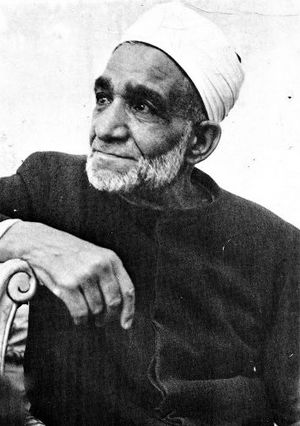Mahmud Shaltut facts for kids
Quick facts for kids
Mahmoud Shaltut
محمود شلتوت |
|
|---|---|
 |
|
| Grand Imam of Al-Azhar | |
| In office 1958–1963 |
|
| Preceded by | Abd al-Rahman Taj |
| Succeeded by | Hassan Mamoun |
| Personal details | |
| Born | 23 April 1893 Minyat Bani Mansur, Itay El Barud, Khedivate of Egypt |
| Died | 13 December 1963 (aged 70) Cairo, Egypt |
Sheikh Mahmoud Shaltut (Arabic: محمود شلتوت; born April 23, 1893 – died December 13, 1963) was an important Egyptian religious leader. He is best known for trying to update and improve Islamic teachings and laws. Shaltut followed the ideas of Mohammad Abduh, a famous Islamic thinker. He became the Grand Imam of Al-Azhar, a very high religious position, from 1958 until his death in 1963.
Contents
Early Life and Education
Mahmoud Shaltut was born in a small village called Minyat Bani Mansur in Beheira Governorate, Lower Egypt. When he was 13, in 1906, he left his village to study. He joined a new religious school in Alexandria that was connected to Al-Azhar University.
He finished his studies in 1918 and earned his Alimiyya Degree. This was like a bachelor's degree from Al-Azhar. The next year, in 1919, he started teaching at the same school. In 1927, when he was 34, he moved to Cairo. There, he began lecturing at the higher levels of Al-Azhar University.
Time at Al-Azhar University
In 1929, Sheikh Mohammad Moustafa al-Maraghi became the head of Al-Azhar University. Al-Maraghi wanted to make big changes, and Shaltut strongly supported him. Shaltut himself had ideas for reform. He believed that religious institutions should be more separate from the government.
However, not everyone agreed with these changes. Al-Maraghi resigned after just one year. Sheikh Mohammad al-Ahmadi al-Zawahiri took his place. Shaltut felt that al-Zawahiri was not as forward-thinking as al-Maraghi. Shaltut was a modernist, meaning he wanted to update Islamic thought for the modern world.
Because of his different views, Shaltut was dismissed from Al-Azhar in 1931. Many others who supported al-Maraghi's reforms were also removed. During this time, Shaltut worked as a lawyer in the Shari'a courts. These courts use Islamic law to make decisions. He returned to Al-Azhar in 1935 when al-Maraghi became the head again.
During al-Maraghi's second time as head, Shaltut became a Vice Dean at the Kulliyat al Shari’a, which is the College of Islamic Law. In 1937, he went to an international law conference in the Netherlands. He was one of only three scholars chosen to represent Al-Azhar. His speech about Islamic law impressed many people and helped him gain more respect.
In 1939, Shaltut became an inspector of religious studies. In 1946, he was elected to the Arabic Language Academy in Cairo. His career continued to rise. In 1957, he became Vice-Rector of Al-Azhar. Then, in October 1958, President Gamal Abdel Nasser chose him to be the Sheikh al-Azhar. This was the highest honor.
Before, Al-Azhar scholars used to choose their own Grand Imam. But in 1961, President Nasser changed the law. He made Al-Azhar a national institution. This new law limited the power of the imams and gave the government the power to appoint the Grand Imam. This change helped the government work with Shaltut. He wanted to modernize the school's lessons and make Al-Azhar serve the Muslim community more widely.
His Vision: Beliefs, Ideas, and Reforms
Soon after becoming Sheikh al-Azhar, Shaltut shared his plans for reform. He wanted to show that Islamic law (shari’a) was not old-fashioned. Instead, he believed it could guide society through modern changes. He strongly wanted Al-Azhar to be more independent from government control. He worked to pass laws like the Reform Law in 1961.
The Reform Law aimed to connect Al-Azhar with other higher education systems. It also wanted to create better job chances for students. The goal was to produce modern scholars who understood today's world. These scholars could then help the Muslim community.
Sheikh Shaltut became very popular. He started regular radio broadcasts where he gave religious talks. He also answered questions from people who had doubts or criticisms. These broadcasts made him even more respected. They were later published as books. Shaltut was also known as a great speaker. He believed that Islamic law was still very important today. He saw his writings on the Quran as practical advice for all Muslims.
His Legacy
Shaltut is remembered for encouraging good relationships between Sunni and Shi'a Muslims. He had close ties with important Shi’i leaders. He worked hard for open discussions and cooperation between these two major branches of Islam. Shaltut wanted to clear up misunderstandings and stop arguments between them. He even issued a special religious opinion, called a fatwa. This fatwa stated that worship according to the Twelver Shi’i way was valid.
Shaltut wanted to show the world that Islam is a religion of unity, flexibility, and balance. He strongly spoke out against division and extreme beliefs. He promoted tolerance and reason among Muslims. Shaltut also accepted socialism and was proud of his Egyptian nationality. At the same time, he supported Arabism, which is the idea of unity among Arab nations.
However, like any famous person, Shaltut had people who disagreed with him. Some saw him as too close to the government. They felt he was serving the government's needs rather than the religion. His ideas about Islamic principles were different from some of his peers. Despite this, his efforts helped shape modern Islamic thought.
Major Works
- Tafsir al-Kuran al-Karim: al-Adjza al-Ashara al-Ula (1959)
- Jihad al-kital fi‘l-Islam (1948)
- al-Islam, Aqida wa-Shari’a (1959)
- al-Fatiwa, Dirasa li Mushkilat al-Muslim al-mu asir fi Hayatihi al-Yawmiyya al-Amma (1964)

